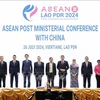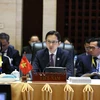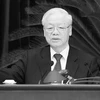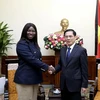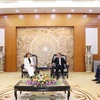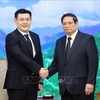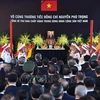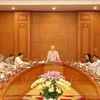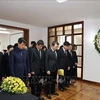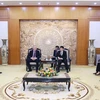To explain the reason for its placement of Haiyang Shiyou-981 oil rig in Vietnam's sovereign waters, China has cited a 1958 Diplomatic Note written by the late Prime Minister Pham Van Dong (the 1958 Note, in short) as a "proof" of Vietnam's recognition of China's sovereignty over the Hoang Sa and Truong Sa archipelagoes.
In an interview with the Vietnam News Agency reporters, Dr. Ta Van Tai – lawyer, former lecturer and currently researcher at Harvard Law School – said there were two international legal arguments showing that China's explanation was absurd.
Declarations of sovereignty
First and foremost, the 1954 Geneva Agreement splitting Vietnam into two parts handed the right of administration of the Hoang Sa and Truong Sa archipelagoes south of the 17th Parallel (the partition line), over to the then Government of South Vietnam (the Republic of Vietnam) south of that parallel.
That is why, any actions asserting and exercising sovereignty over the Hoang Sa and Truong Sa archipelagoes fell under the authority of the then Republic of Vietnam. That government, as well as its navy, powerfully affirmed Vietnam's sovereignty over the islands during and after the 1974 Hoang Sa naval fight between the navy of South Vietnam - then occupying and administering the archipelagoes - and that of China that came to attack.
The late Prime Minister Pham Van Dong of North Vietnam (the Democratic Republic of Vietnam) had no authority or intention to make a declaration about the sovereignty of the Hoang Sa and Truong Sa archipelagoes, which belonged to the Republic of Vietnam at the time. He only made a declaration that recognised China's 12-nautical mile territorial sea claimed by China in Chinese Prime Minister Chou En-lai's declaration.
Even though the aspiration of in the motto "the Vietnamese nation is one, Vietnam is one" was an idealist statement, expressed by many Vietnamese including Ho Chi Minh, the existence of a state is a question of fact, under international law.
Therefore, the actual existence of the two states of Vietnam from 1954 to1975, as the Democratic Republic of Vietnam and the Republic of Vietnam, was in conformity to international law, with the Republic of Vietnam exercising sovereignty over the archipelagoes during that time.
The Socialist Republic of Vietnam was the state that succeeded to the role as sovereign protector over that land. This succession was also dealt with by Prime Minister Nguyen Tan Dung in a speech to the National Assembly on November 25, 2011. He affirmed that in 1974, China used force to occupy the whole Hoang Sa Archipelago under the "actual administration of the then Saigon government, i.e. the government of the Republic of Vietnam. The government of the Republic of Vietnam raised its voice to protest against this attack and proposed the United Nations interfere".
According to the 1933 Montevideo Convention summarising centuries of customary/traditional international law on the issue of the existence of a state, the Republic of Vietnam was an entity that had all the four conditions of a state: (a) a stable population, (b) a clear-cut territory, (c) a government, and (d) the capacity to enter into relations with other states.
When other countries recognise a state possessing these four qualifications and establish relations with it, it is a political decision, which is added to the four legal standards. This means that even if a state does not like another state and does not recognise it, it cannot eliminate the status of that state.
Take Cuba for example. While it is hated and not recognised by the United States, the US cannot eliminate its statehood. The state of the Republic of Vietnam in the 1954-1975 period was recognised by several dozen countries. Even The Soviet Union once proposed that the two Vietnams be admitted to the United Nations.
However, whether a state is admitted into the UN or not, this is only a political matter and admission or non-admission into the UN is not one of the standards set for the birth of a state. The Geneva Agreement could not be used to argue that, because it recommended that reunification of the two temporarily-divided parts of Vietnam be achieved through a general election, the Republic of Vietnam did not exist under the sun. Proponents of this idea did not understand the centuries-old international law on birth of a state. They also mixed up the legal standards for the existence of a state under this law with a political arrangement by world powers in the agreement joined by only a few countries. In so doing, they had intentionally forgotten the political reality that several dozen countries had recognised the birth of the Republic of Vietnam. They had also forgotten international law in the sense that the small number of countries that signed the Geneva Agreement could not deny the rights of the several dozen countries that recognised the Republic of Vietnam.
Prime Minister Nguyen Tan Dung has said, and in the past, presumably the late Prime Minister Pham Van Dong might also have said implicitly (ambiguity in this case is an art of diplomacy and politics) that there were two states of Vietnam during the 1954-1975 period.
Such statement does not reduce the value of achieving national reunification in 1975-1976, because in world history, many states have been divided into several parts and some were then reunified again.
For example, Pakistan was divided in two states, the other being Bangladesh. Sudan was once one state, but now there are two states. These states still have their own positions and are recognised among the community of states.
No legal effect
A unilateral declaration such as the official letter by the late Prime Minister Pham Van Dong has no international legal effect. In international law, it is impossible to try to apply the "Estoppel" theory to this case in Vietnam. The Estoppel theory is from the domestic law of a number of states and stipulates that "once something is said, it cannot be withdrawn". This theory is not applicable in international law in the same way as it is applied in domestic law, because there are very strict conditions. Therefore it is impossible to consider a unilateral statement as inevitably binding under international law. This was stated by an international court in judging a case involving the continental shelf between Germany and Denmark/Holland.
According to another legal case, when considering the significance of a unilateral declaration, the international court must strictly interpret the "intention" of the declarer. According to the decision of the International Court of Justice in "Nuclear Tests Case, Australia & New Zealand versus France, 1974 I.C.J. 253", "When states make statements by which their freedom of action is to be limited, a restrictive interpretation is called for....The sole relevant question is whether the language employed in any given declaration does reveal a clear intention...The Court must form its own view of the meaning and scope intended by the author of a unilateral declaration, and cannot be bound by the view expressed by another state which is in no way a party to the text."
According to the standards of the ruling in that legal case, the intention of the late Prime Minister Pham Van Dong in the 1958 diplomatic note should be considered within the framework of the his role under the 1946 Constitution. As provided by that Constitution, the Government consists of the President, Vice-President and the cabinet (Article 44). In the cabinet, there is the Prime Minister (Article 44). The President, on behalf of the country (Article 49, clause a), signs a treaty with another country (Article 49, clause h), binding Vietnam to such important things as sovereignty over land, including the concession of land. The President's signed treaty to make that land concession had to be ratified by the National Assembly, the supreme organ of power (Articles 22 and 23).
The Prime Minister cannot go beyond his role, according to the principle of the theory called "ultra vires" (going beyond authority).
The official letter of the late Prime Minister only intended to give diplomatic support to China on the 12- nautical mile territorial sea which China was anxious to declare in opposition to the then (1958) threat from the US with its seventh fleet in the Taiwan Strait. Kinmen and Matsu islands in the strait were occupied by the Taiwanese army with strong US support.
Moreover, the intention of the late Prime Minister Pham Van Dong cannot be inferred as relating to land concessions, because China demanded all the Hoang Sa and Truong Sa archipelagoes, but many reefs/islands are claimed by a number of Southeast Asian countries, which he could not represent. China cannot use the words of Dong to oppose the other Southeast Asian countries.
According to the said "Nuclear Tests" case, the international court finds it unnecessary to hear China's subjective and self-interested explanation.-VNA
In an interview with the Vietnam News Agency reporters, Dr. Ta Van Tai – lawyer, former lecturer and currently researcher at Harvard Law School – said there were two international legal arguments showing that China's explanation was absurd.
Declarations of sovereignty
First and foremost, the 1954 Geneva Agreement splitting Vietnam into two parts handed the right of administration of the Hoang Sa and Truong Sa archipelagoes south of the 17th Parallel (the partition line), over to the then Government of South Vietnam (the Republic of Vietnam) south of that parallel.
That is why, any actions asserting and exercising sovereignty over the Hoang Sa and Truong Sa archipelagoes fell under the authority of the then Republic of Vietnam. That government, as well as its navy, powerfully affirmed Vietnam's sovereignty over the islands during and after the 1974 Hoang Sa naval fight between the navy of South Vietnam - then occupying and administering the archipelagoes - and that of China that came to attack.
The late Prime Minister Pham Van Dong of North Vietnam (the Democratic Republic of Vietnam) had no authority or intention to make a declaration about the sovereignty of the Hoang Sa and Truong Sa archipelagoes, which belonged to the Republic of Vietnam at the time. He only made a declaration that recognised China's 12-nautical mile territorial sea claimed by China in Chinese Prime Minister Chou En-lai's declaration.
Even though the aspiration of in the motto "the Vietnamese nation is one, Vietnam is one" was an idealist statement, expressed by many Vietnamese including Ho Chi Minh, the existence of a state is a question of fact, under international law.
Therefore, the actual existence of the two states of Vietnam from 1954 to1975, as the Democratic Republic of Vietnam and the Republic of Vietnam, was in conformity to international law, with the Republic of Vietnam exercising sovereignty over the archipelagoes during that time.
The Socialist Republic of Vietnam was the state that succeeded to the role as sovereign protector over that land. This succession was also dealt with by Prime Minister Nguyen Tan Dung in a speech to the National Assembly on November 25, 2011. He affirmed that in 1974, China used force to occupy the whole Hoang Sa Archipelago under the "actual administration of the then Saigon government, i.e. the government of the Republic of Vietnam. The government of the Republic of Vietnam raised its voice to protest against this attack and proposed the United Nations interfere".
According to the 1933 Montevideo Convention summarising centuries of customary/traditional international law on the issue of the existence of a state, the Republic of Vietnam was an entity that had all the four conditions of a state: (a) a stable population, (b) a clear-cut territory, (c) a government, and (d) the capacity to enter into relations with other states.
When other countries recognise a state possessing these four qualifications and establish relations with it, it is a political decision, which is added to the four legal standards. This means that even if a state does not like another state and does not recognise it, it cannot eliminate the status of that state.
Take Cuba for example. While it is hated and not recognised by the United States, the US cannot eliminate its statehood. The state of the Republic of Vietnam in the 1954-1975 period was recognised by several dozen countries. Even The Soviet Union once proposed that the two Vietnams be admitted to the United Nations.
However, whether a state is admitted into the UN or not, this is only a political matter and admission or non-admission into the UN is not one of the standards set for the birth of a state. The Geneva Agreement could not be used to argue that, because it recommended that reunification of the two temporarily-divided parts of Vietnam be achieved through a general election, the Republic of Vietnam did not exist under the sun. Proponents of this idea did not understand the centuries-old international law on birth of a state. They also mixed up the legal standards for the existence of a state under this law with a political arrangement by world powers in the agreement joined by only a few countries. In so doing, they had intentionally forgotten the political reality that several dozen countries had recognised the birth of the Republic of Vietnam. They had also forgotten international law in the sense that the small number of countries that signed the Geneva Agreement could not deny the rights of the several dozen countries that recognised the Republic of Vietnam.
Prime Minister Nguyen Tan Dung has said, and in the past, presumably the late Prime Minister Pham Van Dong might also have said implicitly (ambiguity in this case is an art of diplomacy and politics) that there were two states of Vietnam during the 1954-1975 period.
Such statement does not reduce the value of achieving national reunification in 1975-1976, because in world history, many states have been divided into several parts and some were then reunified again.
For example, Pakistan was divided in two states, the other being Bangladesh. Sudan was once one state, but now there are two states. These states still have their own positions and are recognised among the community of states.
No legal effect
A unilateral declaration such as the official letter by the late Prime Minister Pham Van Dong has no international legal effect. In international law, it is impossible to try to apply the "Estoppel" theory to this case in Vietnam. The Estoppel theory is from the domestic law of a number of states and stipulates that "once something is said, it cannot be withdrawn". This theory is not applicable in international law in the same way as it is applied in domestic law, because there are very strict conditions. Therefore it is impossible to consider a unilateral statement as inevitably binding under international law. This was stated by an international court in judging a case involving the continental shelf between Germany and Denmark/Holland.
According to another legal case, when considering the significance of a unilateral declaration, the international court must strictly interpret the "intention" of the declarer. According to the decision of the International Court of Justice in "Nuclear Tests Case, Australia & New Zealand versus France, 1974 I.C.J. 253", "When states make statements by which their freedom of action is to be limited, a restrictive interpretation is called for....The sole relevant question is whether the language employed in any given declaration does reveal a clear intention...The Court must form its own view of the meaning and scope intended by the author of a unilateral declaration, and cannot be bound by the view expressed by another state which is in no way a party to the text."
According to the standards of the ruling in that legal case, the intention of the late Prime Minister Pham Van Dong in the 1958 diplomatic note should be considered within the framework of the his role under the 1946 Constitution. As provided by that Constitution, the Government consists of the President, Vice-President and the cabinet (Article 44). In the cabinet, there is the Prime Minister (Article 44). The President, on behalf of the country (Article 49, clause a), signs a treaty with another country (Article 49, clause h), binding Vietnam to such important things as sovereignty over land, including the concession of land. The President's signed treaty to make that land concession had to be ratified by the National Assembly, the supreme organ of power (Articles 22 and 23).
The Prime Minister cannot go beyond his role, according to the principle of the theory called "ultra vires" (going beyond authority).
The official letter of the late Prime Minister only intended to give diplomatic support to China on the 12- nautical mile territorial sea which China was anxious to declare in opposition to the then (1958) threat from the US with its seventh fleet in the Taiwan Strait. Kinmen and Matsu islands in the strait were occupied by the Taiwanese army with strong US support.
Moreover, the intention of the late Prime Minister Pham Van Dong cannot be inferred as relating to land concessions, because China demanded all the Hoang Sa and Truong Sa archipelagoes, but many reefs/islands are claimed by a number of Southeast Asian countries, which he could not represent. China cannot use the words of Dong to oppose the other Southeast Asian countries.
According to the said "Nuclear Tests" case, the international court finds it unnecessary to hear China's subjective and self-interested explanation.-VNA
